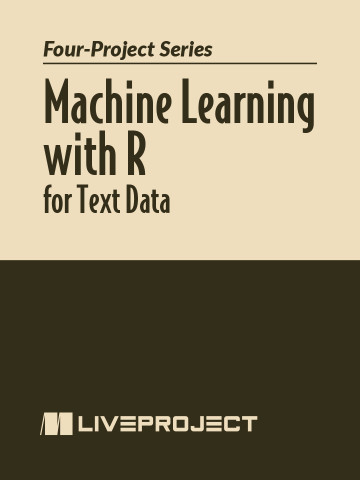- prerequisites
- intermediate R, particularly tidyverse • basic understanding of text data structures • intermediate ML • intermediate DL
- skills learned
- import and clean data • tokenize and clean text data • feature engineering • fit models using a tidy workflow • evaluate classification models • tune ML models • resample datasets • implement pre-trained word embeddings in an ML workflow • explain how an ML model generates specific predictions
pro $24.99 per month
- access to all Manning books, MEAPs, liveVideos, liveProjects, and audiobooks!
- choose one free eBook per month to keep
- exclusive 50% discount on all purchases
lite $19.99 per month
- access to all Manning books, including MEAPs!
team
5, 10 or 20 seats+ for your team - learn more

Picture this: You’re an academic researcher tasked with helping social scientists determine the U.S. government’s responsiveness to public demands. A clear expression of this responsiveness is examining the types of policies legislators seek to advance. In this series of liveProjects, you’ll apply machine learning to generate predictions of the policy focus of each congressional bill in a legislation dataset. Leveraging tools widely used by data scientists and academic researchers—including R, the tidymodels framework, feature engineering techniques, and ML algorithms—you’ll perform exploratory data analysis (EDA) to prepare for predictive modeling, preprocess the text data, develop core ML models, and train DL models.
here's what's included

Step into the shoes of an academic researcher tasked with predicting which areas will be the focus of the U.S. government’s policy-related efforts. In this liveProject, you’ll prepare for predictive modeling by exploring the policy areas and text descriptions in legislation data, using statistical visualizations and ggplot2, and identifying notable trends and outliers.

Play the role of an academic researcher preparing a machine learning model to predict the U.S. government’s focus for new policy legislation. You’ll process the legislation dataset with resampling and feature engineering techniques, employ a range of algorithms, including penalized regression and XGBoost, to fit a series of ML models, evaluate the effectiveness of the models, and tune them accordingly.

Imagine you’re an academic researcher working on a project for predicting trends in the U.S. government’s policy-making priorities. Using modern techniques for text data feature engineering, you’ll fit a set of models, subsample the training data to minimize bias, evaluate the models’ performance using a test-set of observations, and leverage a tidy workflow to explain how a model generates specific predictions.

Predict the future! You’re an academic researcher working on a project that predicts what policy areas the U.S. government will prioritize. To achieve your goal, you’ll train three kinds of deep learning neural networks on a legislation dataset (a CSV file containing one row for every bill introduced in the U.S. Congress). With the resulting text classifications, you’ll predict the area of focus for future policy bills.

team
- five seats for your team
- access to all Manning books, MEAPs, liveVideos, liveProjects, and audiobooks!
- choose another free product every time you renew
- choose twelve free products per year
- exclusive 50% discount on all purchases
-
![]() Machine Learning with R for Text Data project for free
Machine Learning with R for Text Data project for free
Prerequisites
These liveProjects are for data analysts familiar with writing basic code in R and who have prior experience working with machine learning techniques. To begin these liveProjects, you’ll need to be familiar with the following:
TOOLS- Basic knowledge of R, particularly tidyverse
- Basic understanding of text data structures
- Intermediate understanding of machine learning workflows (machine learning algorithms, loss functions, cross-validation, metrics and model evaluation)
- Intermediate understanding of deep learning models
 features
features
- Self-paced
- You choose the schedule and decide how much time to invest as you build your project.
- Project roadmap
- Each project is divided into several achievable steps.
- Get Help
- While within the liveProject platform, get help from fellow participants and even more help with paid sessions with our expert mentors.
- Compare with others
- For each step, compare your deliverable to the solutions by the author and other participants.
- book resources
- Get full access to select books for 90 days. Permanent access to excerpts from Manning products are also included, as well as references to other resources.


 Machine Learning with R for Text Data project for free
Machine Learning with R for Text Data project for free